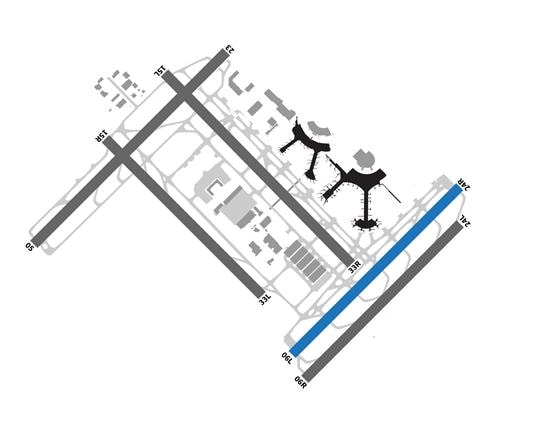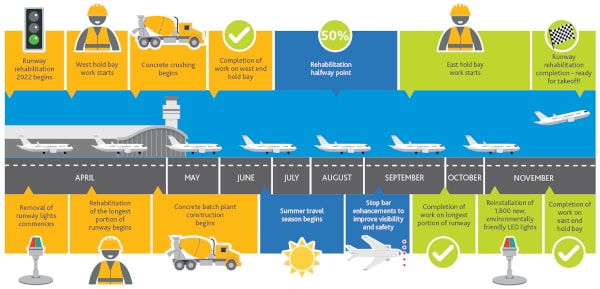Learn more about the largest runway projects in the airport’s history.
What you'll learn on this page:
- Project overview
- Project timelines and community impacts
- Project benefits
- Keeping you informed
- Questions and answers
Like all major infrastructure, our runways need regular maintenance to keep them safe.
Starting in early April 2022, Pearson temporarily closed east/west runway 06L/24R, the airport’s second-busiest runway, for a full rehabilitation.
This project represents one of the largest runway repair projects in the airport’s history. The work will be completed in phases and will last to late Fall.
First built in the 1960s, this 3-km runway needs to be fully repaired due to the wearing down of its concrete sub-structure because of weather conditions, use and time. This project will extend the life of the runway by 30 years and enhance the safety of the runway.

Project overview
The work started in early April 2022 and will last to late Fall 2022. Impacts will vary with the nature of the work and how it affects operations.
We are working in close partnership with our industry partners and construction contractor to deliver a project that minimizes impacts.
Despite these efforts, communities near the airport, including those who typically have fewer aircraft overhead, can expect more aircraft noise during the project.
It is important to remember, there is no permanent airspace change associated with this project and any impacts are temporary and only for the duration of the project.
Phase 3 update:
Great news! Significant progress has been made on our Runway 06L/24R rehabilitation—one of the biggest in the airport’s history. The project is now moving into Phase 3.
Phase 3 is scheduled to last through November.
Our Sustainability and Social Impact team continues to engage with our communities and educate residents on the benefits and impacts of this project, and on September 28th, interested residents will have the opportunity to take part in a virtual update with the project team. The invite is open to anyone, so if you’re interested in joining, please register in advance.
Project timelines and community impacts
|
|
Phase 1 |
Phase 2 |
Phase 3 |
|
Dates |
Early April to June, 2022 |
Late June to mid-September 2022 |
Mid-September to mid-November, 2022 |
|
The Work |
West end of runway - full depth replacement and lighting upgrade of runway end and holding bay |
Work on middle portion: full depth replacement and lighting upgrade of runway and adjacent taxiways |
East end of runway - full depth reconstruction and lighting upgrade on runway, holding bay and adjacent taxiway |
|
Community Impacts |
|
|
|
Project benefits

SAFETYThe project will ensure the continued safety of operations at Pearson, including the safety of passengers, employees and our communities |
|
WORKING GREENERThe project will include the use of recycled materials and upgrades to 1,800 LED lights, which will help enhance safety and reduce the carbon footprint of the runway. Other environmentally friendly construction practices include using crushed concrete from the runway pavement removal for the sub-base and base materials, and recycled milling asphalt materials to build approach roads in the vicinity of the runway. |
|
BUILDING BACK BETTERA strong Toronto Pearson will support a strong region, strong province and strong Canada, enabling foreign direct investment, trade, tourism and critical goods movement to keep Canada’s supply chain moving. This work will contribute millions of dollars to the local economy and create meaningful jobs. |
|
FUELING THE REGIONThe runway rehabilitation project will create over 4,000 jobs and inject millions of dollars into Ontario’s economy, helping to spur a strong recovery for the region and the country. |
|
MITIGATING IMPACTSWe have reduced airline slots and adjusted schedules for the duration of the project to mitigate operational and community impacts. We will continually reassess our approach for the duration of the rehabilitation to minimize impacts to communities surrounding the airport. |
How runways are configured to manage traffic
Below are three ways that runways are configured as a system to maximize efficiency based on traffic levels:
- Land one, depart one - one runway is used for arrivals, and another for departures. The main arrival runway can also be used for surplus departures when arrival traffic is low, and the main departure runway can be used for surplus arrival traffic when departure traffic is low. This operation is used under low traffic levels such as throughout the pandemic.
- Dual configuration (East/West only) - two parallel runways are used simultaneously, with each runway handling a mix of arrivals and departures.
- Triple configuration (East/West only) - is when all three of the East/West runways are in use, with one runway being used to alternate between arrivals and departures, and the remaining two being used exclusively for arrivals or departures.
- A Dual or Triple configuration is used under high traffic levels such as prior to the pandemic (2019).
Traffic is nearing 2019 levels. Historically the airport would have used a Dual or Triple configuration to manage this level of traffic. Given the temporary closure of Toronto Pearson’s second busiest East/West runway, Runway 06L/24R, runways must be configured differently to handle this volume.
During the 2022 Runway Rehabilitation project the runways are configured as described below:
- East/West – a land one, depart one configuration is used with a main runway used for arrivals and a main runway used for departures. The main arrival runway may be used as a secondary departure runway in periods of higher departure traffic; similarly, a main departure runway may be used as a secondary arrival runway in periods of higher arrival traffic than departure traffic. This secondary traffic is called offloads.
- During the Runway Rehabilitation, the airport will be operating in a land one, depart one in a traffic level scenario that would usually call for dualling or tripling.
- Because of this, offloads may be more frequent, and residents affected by the ‘main’ runways can expect more traffic and may feel like more traffic compared to how it might have felt in 2019.
- North/South – at times, depending on temporary restrictions on the airfield during different phases of the runway rehabilitation, the North/South configuration will be able to handle a higher rate of traffic than a land one, depart one East/West configuration. Should the traffic volume be too high for to accommodate on the two East/West runways, a North/South configuration will be used (Runways 15L & 15R or Runways 33L & 33R). This means that residents affected by North/South runway operations can expect more traffic.
Keeping you informed
Virtual project update
Please join us for a virtual project update on Wednesday, September 28 at 6:00pm to learn more and ask questions directly to the project team. Please register in advance.
Our commitment to you is to keep you informed of the latest updates on this page to help you plan ahead, so please check back regularly. Here are a few other ways to help you stay in the know:
Call the Noise Management Office at 416-247-7682. Register a complaint online using the complaint form or WebTrak. Alternately, you may also visit our Noise Advisory page
Email a question or invite us out to you community for a briefing: community.engagement@gtaa.com
To learn more about airport operations and community impacts, please visit our interactive tool, InsightFull: airportnoise.torontopearson.com.
Sign up for our monthly newsletter.
For information about ongoing regular maintenance, please see our Noise Advisory page.
Questions and answers

